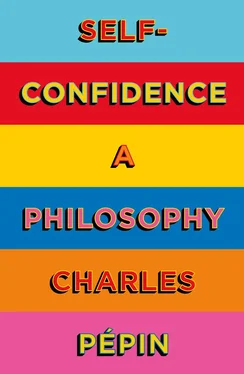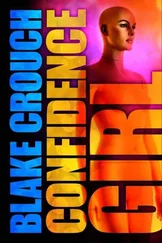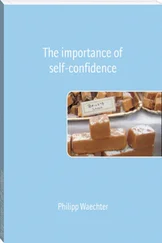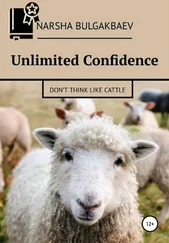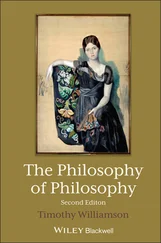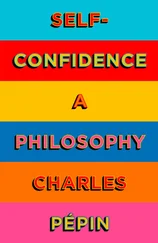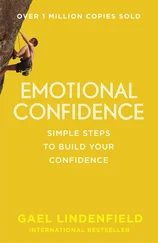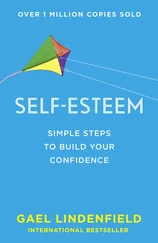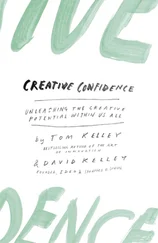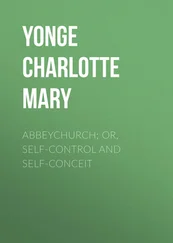As soon as our skill or ability tells us something about ourselves, we are no longer locked within the strict logic of competence. When our ability is compartmentalised, it doesn’t help us overcome our anxieties. If we develop a skill thinking that it will give us a broad power over the unexpected, we run the risk of having our confidence shaken when something truly unexpected happens. Life is all too good at confounding our forecasts. If we increase our mastery with the illusion that it will give us total control, we are setting ourselves up for disappointments that will undermine our confidence. We have to develop our mastery while recalling that we will not be able to master everything, that things never repeat themselves identically.
‘We never step twice into the same river,’ says a fragment from the teachings of Heraclitus. Even if our skill level is very high, the second time something happens is never an exact repetition of the first. A surgeon may have a thorough knowledge of the actions he needs to perform, the tools, the timing, but he must deal each time with a new human body, identical overall but individual in its particulars and therefore different. His skill allows him to deal with any novel aspects; it is layered and extensive enough that he can adapt to any unforeseen features of a case. Serena Williams may be extraordinarily skilled, but the first time she saved match point in the finals of a Grand Slam tournament, it was very much her first time doing it. And the two other times were not identical reconstructions of the first. If the surgeon and Serena Williams managed to come up with the right reaction, it’s because they could draw on their great skill. They performed actions that they had mastered perfectly. But they did more than that. They performed them without a tremor, although they were not simply repeating a gesture mechanically. They were able to be inventive, to adapt to the situation, even if minimally, and that’s what makes all the difference.
In Thus Spake Zarathustra , Nietzsche imagines a grotesque character, the ‘Conscientious One’, to illustrate the difference between competence that walls a person off, and experience that gives freedom. In Nietzsche’s view, it all hinges on what we have ‘in the pit of our stomachs’ when we set out to develop competence. If we are driven solely by the ‘instinct of fear’, if we are working toward expertise because we are afraid of the unknown, then we will never draw true confidence from it. We will be skilful but not confident, like the sinister ‘Conscientious One’. An expert of sorts, a pathetic version of the researcher, he knows everything, absolutely everything, about the brain of the leech, but his great competence in his chosen field cuts him off from life, since nothing else interests him. His unusual expertise will eventually kill him, in a surreal scene that displays Nietzsche’s comic genius. Falling into a marsh swarming with leeches, the ‘Conscientious One’ will be sucked dry of his own blood, devoured by the very object of his expertise.
Fortunately, we can take the opposite approach to expertise, using what Nietzsche calls the ‘instinct of art’, a form of creativity that he contrasts with the ‘instinct of fear’. It will allow us to extend and develop the life within us, not run away from it. It will make us more alive, not less so. Our actions will be guided by curiosity, not the instinct to ball up into a cocoon. Naturally, we harbor both these instincts within us, the fear instinct and the art instinct. Each time that the art instinct wins out over the fear instinct, each time that our creativity wins out over our instinct to curl up into a ball, we make it more likely that competence will translate into confidence.
Let us take Zarathustra’s advice, therefore: let us develop our abilities, but with the soul of an artist, and let us use our abilities as a springboard, not a palisade. Our skills, our areas of strength, reassure us, certainly, but let’s not forget the goal of this reassurance, which is to come out of our comfort zone and have confidence in ourselves. If we work on our abilities with the aim of finding complete reassurance, we will not be able to have true confidence in ourselves, for a reason that Nietzsche diagnosed with pitiless accuracy. Life is unpredictable, at times unfair, and, when you come right down to it, anxiety-producing. As long as we remain lucid, we will never live with complete reassurance.
Our competence, then, must be more than the ability to repeat what we already know how to do. It must become the field in which our creativity develops, the occasion for us to be present to our true selves. This change is possible only as the upshot of a long and slow process: mastery leads us gradually to the acceptance of a kind of ‘non-mastery’, of letting go. Thanks to everything we have learned, experienced, and integrated, we give ourselves the permission to have confidence in ourselves.
Serena Williams started playing tennis at the age of three: her feet, as she sat on the courtside bench, didn’t reach the ground. She learned the different tennis strokes, gradually hitting them better and better until her competence rose to a very high level. But when, in three separate finals, she had to save match point and did so without a tremor, she didn’t just have confidence in her strokes, she had confidence in herself. From repetition, her competence was incorporated into her and became second nature. The leap that I spoke of had occurred, and her competence had become confidence.
This leap remains somewhat mysterious. But there is one thing we do know about it: in order to accomplish that leap, we need to regularly re-immerse ourselves in our mastery so as to have the courage to take a step into ‘non-mastery’, reassure ourselves in our comfort zone so as to then be able to leave it.
Think of your comfort zone, your area of competence, as a circle. You go into it to soak up warmth. Then you leave it to explore the big world beyond. You come back to it to be reassured again. And so on. Compose yourself inside your comfort zone, only to re-emerge from it each time. Dancing. Moving forward. Enlarging both the circle of your comfort zone and the boundaries of your exploration. To a rhythm. This dance step, this two-step waltz, gives us a model for the way self-confidence operates. Each person has to know himself well enough to sense how often he will need to re-immerse himself in his comfort zone. The less security we received in childhood, the more often we will need to reassure ourselves. You must know yourself well to find the rhythm that works for you, your dance.
My students acquire various abilities: they master certain concepts that are part of the curriculum. As the time approaches for them to take the baccalaureate exam, they sometimes get nervous at the thought of all the topics we haven’t covered. They ask me to give lectures or distribute handouts on the skipped concepts. I urge them instead to review the ones they have already mastered. To reread the lectures they liked. To re-experience pleasure, which is the best ally of confidence. In a word, I tell them to re-immerse themselves in their comfort zone. And afterwards, but only afterwards, to go out and discover new concepts. I invite them to dance this two-step waltz.
I also advise them to get in training by writing short introductions or essays. ‘It’s by blacksmithing that you become a blacksmith,’ says a medieval proverb. Even Hephaestus, the god of blacksmiths, didn’t become a blacksmith overnight. Because of his ugliness, his parents threw him into the sea when he was born. He was rescued by nymphs, who raised him and, over the years, taught him the art of blacksmithing. Hephaestus, the god of the forge, had to put in at least 10,000 hours of practice! I ask my students to train, but I also warn them against the idea that by increasing their skills they will automatically get a better result – the topic they are given on the baccalaureate exam is likely not to resemble any topic that has come up before. This is one of the chief difficulties of being a teacher: you must instil competence in your students, while paradoxically teaching them to mistrust competence in and of itself.
Читать дальше
